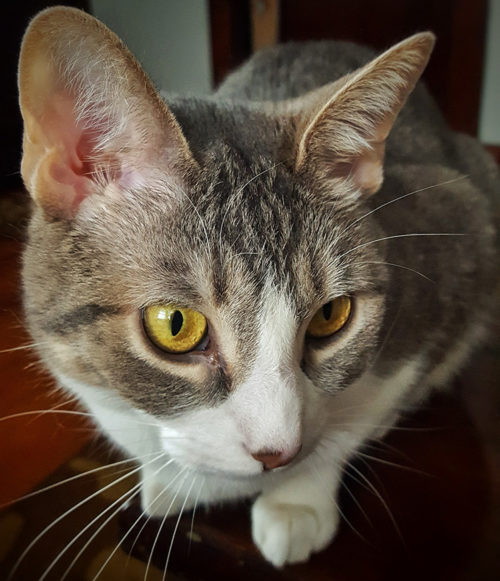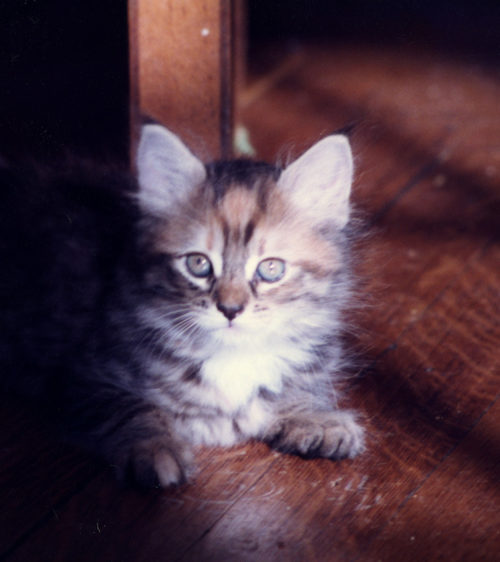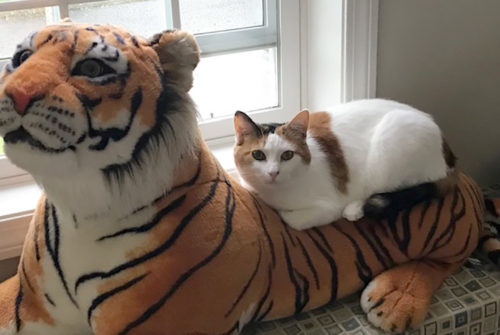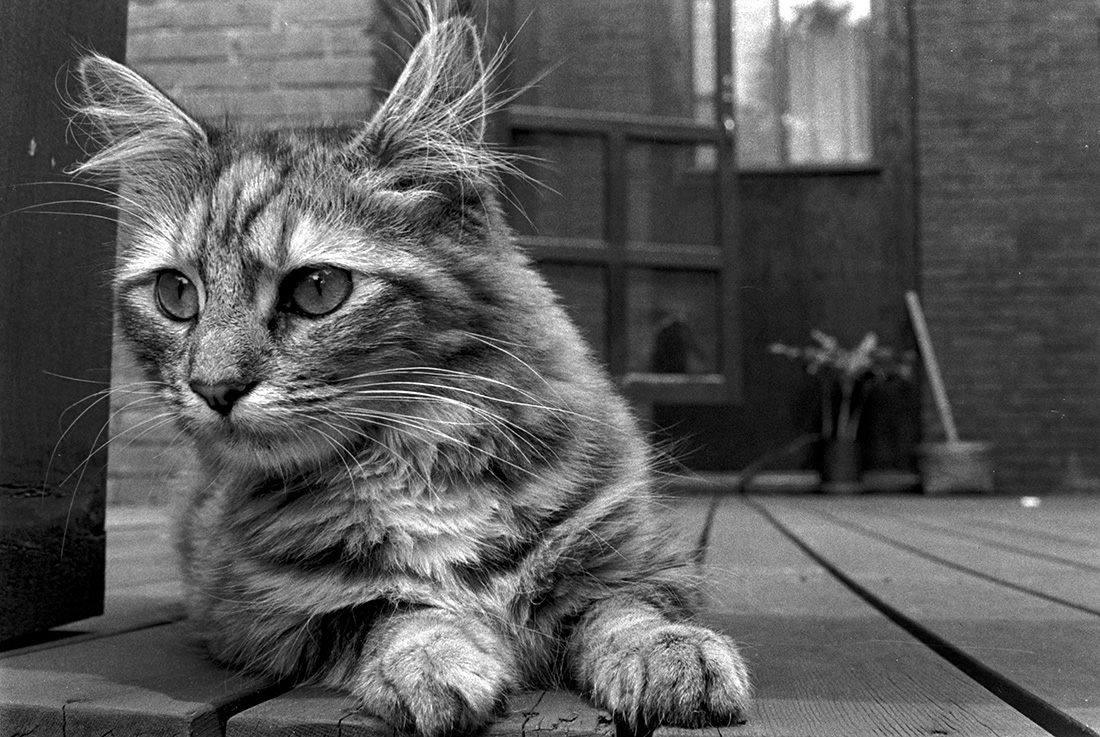Cat People

I’ll start this article about cats with a dog: Jamie, my childhood dog. The dog of dogs. I could wrap my arms around him and hug or wrestle. I could use him as a pillow. A thick-coated shepherd-collie mix, he treated me as his personal charge. When we kids swam, he patrolled the pool edge and sometimes jumped in in his eagerness to protect us. Then we had to fish him out.
But even Jamie didn’t keep me from longing for a cat and, when I was seven or eight, my begging paid off. After that, my family always had a cat. No, to be honest, I always had a cat, and the rest of the family put up with us.
But what are cats really? In contrast to dogs, it’s hard to get a fix on them. Cats dictate the terms of any relationship. Dogs do this to some extent, because you can’t alter a dog’s basic character, but a dog bends to those around it. A dog wants to be part of the group. A cat simply is. This makes cats disconcerting, even a little frightening, to many people, but attractive to others—with somewhere in the vicinity of 54-58 million cats in the U.S. (though it’s hard to know exactly). Why are some of us so drawn to these creatures?
Maybe it’s because we can’t get a fix on them. Because cats embody both closeness and distance. Because a cat may purr one second and scratch the next. They curl in our laps and keep themselves to themselves, autonomy intact, at the same time. They’re part of our daily lives yet unknowable. They’re two beings in one, a puzzle.
Taxi was the first cat of my adulthood. The ad in the newspaper promised Free Kittens. Maybe it should have said: Free the kittens. Because at the apartment, a toddler gleefully pursued them around the living room. They were long-haired orange tigers except for the runt, whose coat was orange, brown, tan, gray, and white. With a tiny face and immense ears from which fur tufted, she cowered beneath a chair. Instead of choosing the friendliest or most relaxed kitten, I chose the one who needed to get out of there the quickest. I tucked her into my parka and took her home.

For several weeks, Taxi stuck close, sitting on my lap or stretching across my shoulders, but that didn’t last. She rapidly turned into a self-contained, self-sufficient, and resourceful cat. She squirmed out of my arms. If anyone went too far or too long in petting her, she set her teeth on a finger or wrist with a surprisingly polite warning: persist, and you will be bitten. She came and went as she pleased, through the front door, the side door, the back door, and most of the windows. One of my roommates once reported seeing her grazing on spilled garbage with a couple of dogs around the corner. Apparently, even strange dogs didn’t faze her. I would’ve preferred a laid-back cuddly cat, but I admired her.
At night, she would sometimes settle on my chest with her nose inches from my face, purring, but at other times, I’d glance across the room and see stark wildness in her stare. Not only a room but a gulf divided us.
In fact, cats are still part wild.
Descended from the species Felis sylvestris lybica, cats probably started their long, and what the animal researcher John Bradshaw calls “haphazard,” journey into our homes about 10,000 years ago. As early human agricultural settlements attracted mice, bolder wild cats ventured into these new hunting grounds. They stalked the granaries and, like Taxi, grazed on our garbage. Since these little predators served a vital purpose, humans let them stay and eventually caught and tamed kittens. Robust evidence of their presence begins to show up in Egypt about 4,000 years ago.
Cats haven’t changed that much. At a distance, you probably couldn’t tell the difference between a wildcat and a housecat. Because cats met our needs just as they were, humans didn’t breed them. We needed mousers, and they fit the bill. The characteristics of other domesticates—docility, low reactivity, and dependence—would have served them poorly as hunters. As domesticated animals, cats were an afterthought. In fact, cat breeding of any kind is only about 150 years old, a blip in human-feline history, and so far we’ve bred them only for their looks (though the aesthetic appeal of the Cornish Rex escapes me). While dogs and humans have shaped each other for thousands and thousands of years, cats and humans have not. As veterinarian Nicholas Dodman colorfully described them, “A cat is in some ways like a miniature tiger in your living room.”

Paprika on a toy tiger.
The image of a tiny tiger is certainly a mismatch for many cats. My sister’s calico Heather let pre-schoolers dress her up and roll her around in a baby carriage. My long-haired orange tabby Ruby clambered onto my shoulder every evening when I arrived home and let me hold her like a baby. Some neighborhood cats stroll out to greet me, roll on the sidewalk, and let me rub their bellies. Housecats are not wild. Living and breeding in proximity to people selected gradually for tameness, and Felis sylvestris lybica became Felis catus. You don’t want an actual wildcat in your living room. They really are tiny tigers.
Still, though some housecats let four-year-olds dress them up like babies, Felis catus is not entirely domestic either. No matter how well fed, they hunt if they can (an ecological problem in many places). They respond to many situations the way wild animals do, by bolting and hiding. They resume lives in the wild far more readily and successfully than dogs do, and kittens born feral remain feral unless, like their ancient ancestors, they’re caught and socialized very young. Feral cat colonies abound though they remain mostly invisible to humans.
Stop and think about it: It’s strange to share our homes with such animals. Why do we? Few of us need mousers anymore. Dogs resemble us much more closely and bond strongly with us, because they’re highly social and belong with others. Cats aren’t social in the way dogs and people are. It’s not that they’re asocial––many feral cats live in colonies, and mother cats will nurse each other’s kittens––but Felis sylvestris lybica evolved as a solitary territorial creature, and housecats’ social ways can be as opaque as their stares.
The great cartoonist Gary Larson created a pair of cartoons about what dogs and cats hear when we talk to them. In the dog’s cartoon, the speech bubble reads: Ginger blah blah blah blah Ginger blah blah Ginger blah blah blah. Though he’s onto something, he’s also wrong. As any dog person knows, dogs recognize certain brief, clear, and relevant words. A few smart, hard-working dogs recognize hundreds and even thousands after careful training (check out stories about two border collies, Rico and Chaser). But Alexandra Horowitz, in Inside of a Dog, insists that “to say that dogs understand words is a misnomer.” Genius dogs aside, your average dog hears and responds to tone, stress, cadence, and pattern—the music and emotion of speech—and makes sense of particular sounds in context.
In the cat’s cartoon, the speech bubble reads: nothing at all. He got this right. Frankly, cats don’t give a damn about our speech, musical or otherwise. (With their acute hearing, they may be highly sensitive to noise, our voices included.) They attend to us to please themselves when and if it suits them. But the verb please and the phrase if it suits them here are way too anthropomorphic. They watch us for their own reasons, feline reasons, whatever they may be.
Cats “lead a sort of double life––half domestic, half wild; part culture, part nature,” James Serpell concludes in a short history of the domestic cat. They live right on the boundary that we (at least in the West) have labored to draw between the domestic and the wild. They’ve got two paws in and two paws out. We use words like aloof, inscrutable, superior, haughty, and entitled to describe cats, as if they hold themselves apart from us poor plebes and reap the benefits of domestic life without paying their dues the way other domestic animals, including humans, do.
For most of our existence, our species roamed the woods and hills to gather food. Neither particularly fast nor strong, humans hunted and were hunted. Then, thousands of years ago, we began to live intimately with animals. Instead of hunting them, we raised, cared for, used, and ate them. Either way, as hunter-gatherers, herders, or farmers, we tuned our senses and our intelligence to nature and the lives of animals.
No more. Now, many of us humans inhabit what some call a “post-animal” world. And as our lives grow increasingly urban and remote from nature, we get more and more pets—as if we can’t stand to live entirely apart from nature and animals.
This may help explain why we’re drawn to pets in general, but cat people are drawn to something particular. Maybe it’s precisely because every cat embodies in its twoness and intimate strangeness both the domestic and the wild. The cat observes us from a perch at the edge of the living room, but also swivels its head to gaze in the other direction, back into the wild, where we both come from.
Then the little tiger hops down, trots over, and asks for a head scratch—unless that cat is Taxi, who never stooped so low.

Photo by Susan A. Bernstein
References (in the order of their first appearance):
Karen Brulliard and Scott Clement, “How Many Americans Have Pets? An Investigation of Fuzzy Statistics.” The Washington Post, January 31, 2019, washingtonpost.com.
John Bradshaw, Cat Sense. Basic Books, 2013.
Abigail Tucker. The Lion in the Living Room. Simon & Shuster, 2016.
Alexandra Horowitz, Inside of a Dog. Scribner, 2009.
James Serpell, “Domestication and History of the Cat,” in The Domestic Cat, 2/e. Cambridge University Press, 2000.
